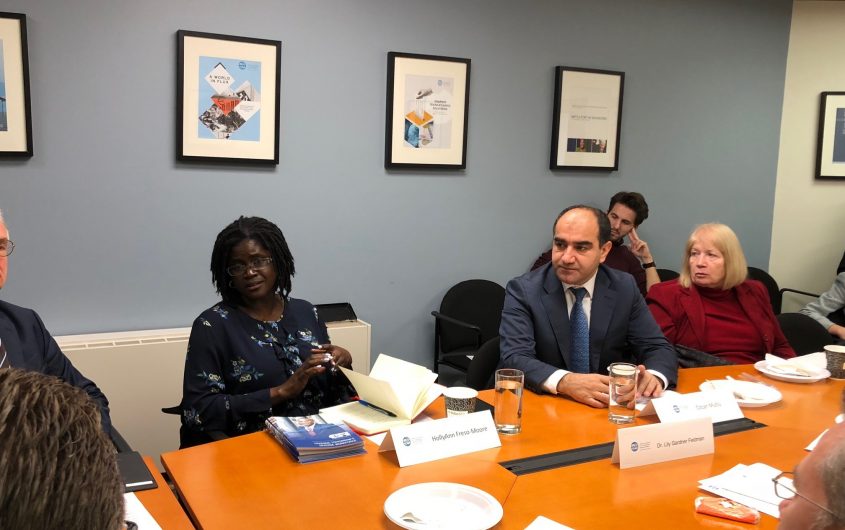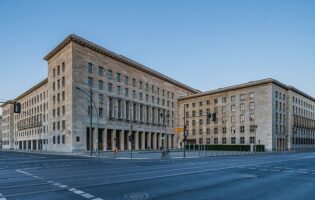
How Much Can Education Serve as a Mechanism for the Integration of Minorities and Immigrants?
Experiences from Germany and the United States
In both the United States and Germany education is key for the successful integration of society and an acceptance of diversity. Diversity education, teacher training, and teachers that are more reflective of their students are all important in both combatting far-right, anti-immigrant sentiments and student success. On December 3, 2018, AGI hosted a seminar to discuss issues of education and integration in both Germany and the United States. Özcan Mutlu, a Turkish-German Green party politician and former member of the German Bundestag, presented the importance of intercultural education in Germany and HollyAnn Freso-Moore, principal of the Carlos Rosario International Public Charter School’s Harvard Street campus, presented the challenges for adult learners and the goal of adult education in the United States.
German Perspective
Though intercultural education is important in developing more accepting attitudes toward diversity, the education system in Germany varies by federal state and the parties in power determine the ideological tone of education. As the number of German students with an immigrant background continues to grow, education must also evolve to reflect the multicultural society. Additionally, structural discrimination against immigrants and those with an immigrant background is hindering their advancement into teaching positions, thus continuing a cycle of low-representation in the classroom.
- Education is a key issue for integration
- The better educated, the better integrated
- Inter-cultural education is crucial
- Study found that the losers of the systems were kids from immigrant backgrounds
- Four times less likely to be as educated as counterpart with a non-immigrant background
- Numbers have improved somewhat, but still challenges to overcome
- School system in Germany is federal, thus sixteen different school systems ruled by different political parties
- Education is ideologically different based on which party is in control in a specific federal state
- Different goals in the different school systems – some focus on Gymnasium, Realschule, etc.
- 40% of young Germans have a non-German background
- Education must reflect that it is a multicultural, multiethnic society
- Recent election – many Turks voted in the Turkish election (for Erdogan)
- But why are they feeling the need to vote in Turkish politics and not getting involved in German politics
- Failed to impart upon immigrant children certain German values
- Teachers are not trained on how to deal with diversity – if do not give the teachers to tools to deal in such an environment, then produced failing biographies
- The Green Party program believes school is an important place for integration
- Sensitivity training, reforming of textbooks, accepting multilingual programs in schools, hiring more young teachers with a diverse background (including more Turkish and Arab teachers)
- Nearly 30,000 teachers in Berlin, only 300 have a Turkish/Arab background
- Average age of teachers is 55
- Need around 40,000 new teachers in Berlin in the coming years to keep the system working
- Teacher training has been cut by many university programs, which has led to people not educated in pedagogy to be teachers
- Why is intercultural education important?
- Intercultural education is good to fight right-wing extremism
- It will also help immigrants feel more protected and take more of a role in domestic German populations
- Without intercultural education, it is very easy for populists like AfD/PEGIDA to find ground, especially in Bundesländer with low levels of immigrants, such as Dresden (with less than 1% Muslim population)
- Immigrants as scapegoats – this is in part a problem of lack of education, people believe this because they are not exposed to immigrant/Muslim populations
- Intercultural education is good to fight right-wing extremism
- Number of refugees participating in vocational programs has increased within the last fifteen years from about 1,000 to 15,000 in 2017
- Since the 2005 immigration law, newcomers to Germany are required to take part in integration courses. The recent government also put in more money for integration programs, as the number of those applying for integration programs exceeded capacities.
- Institutional discrimination still exists for minority students; 60% of immigrant pupils are put into Hauptschule (vocational-track high school), while only 10-15% in Gymnasium (university-track high school), despite academic capabilities (elementary school teachers recommend which high schools pupils should attend)
- Issue of hybrid identities not being accepted
- Diverse education must begin at an early age – someone with an immigrant background may feel 100% German, but if the population does not see them as German, then they will never be truly accepted
- Sensitivity training, reforming of textbooks, accepting multilingual programs in schools, hiring more young teachers with a diverse background (including more Turkish and Arab teachers)
American Perspective
An education that is culturally sensitive and reflects the backgrounds of students in crucial to their academic success and integration into the American society. Adult education programs should also allow students to weave their own beliefs and cultures into their own education. The factors that most limited adults’ ability to further the education were shown to be the price of housing, balancing of priorities like work and childcare, and transportation costs—local government can be key in helping students overcome these barriers.
- There are currently nine adult charter schools in D.C.; most students fall between late twenties and early forties
- Key is the student services department, which focuses on barriers and what prevents students for learning
- Price of housing is an impediment to education. To access Carlos Rosario School’s services, students must live in DC, where rents are climbing higher and higher.
- Childcare is also an issue for adult learners. In addition to attending school, students often work two full-time jobs, which means more childcare costs.
- Juggling work, childcare and other responsibilities makes education hard
- Transportation costs are also increasing, especially as people must move further from the city center to access housing, they must travel greater distances.
- D.C. government has started a transportation subsidy to help adult learners, which shows how local government can help support adult learners. Local government can also provide adequate funding to schools.
- There is still trouble finding educators that speak the languages of the students. Students at Carlos Rosario come from 85 countries and speak 43 different languages.
- Issue of recruiting
- 80% Caucasian teachers nationwide, D.C. is doing better, but it is still difficult to meet the demographic background of the students
- Trying to support a pipeline to education careers for people of color; Carlos Rosario School is developing an education program for students to meet need of bilingual teachers in DC
- Integration is also part of the school’s strategic plan, fusing classroom education and development of community service and civic education
- Focus on civic engagement, ex. early voter fieldtrip, voting education
- Try to understand the desires of the students and how they want to fit in and support their communities
- Citizenship ambassador programs – many people do not know where to begin to become a citizen and thus this program helps students understand the citizenship process, from how to begin the application to how much it costs
- Education as a way to impart values
- Important that students can also weave their culture/values/beliefs into their own education
- Salad bowl vs melting pot
- Everyone has to have a seat at shaping the values of the society
- Leads people to feel more patriotic








